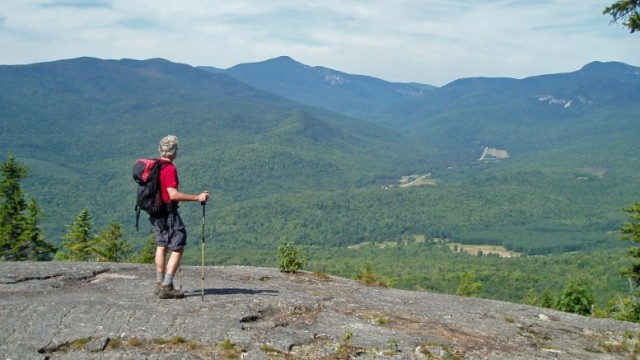
Take these Essentials For Hiking Safely with you every time you go hiking:
#1 The Right Attitude: The first essential is desire to get up off your butt and out into the real world. You have to want to feel rocks and earth under your bootsoles instead of pavement, hear the sounds of wind in the trees and bird calls instead of the tunes on your iPod, to see a widescreen view of miles real countryside, not views measured in inches on a TV screen. The right attitude also includes understanding that the sun isn’t always going to shine, the rain isn’t always going to hold off, and that the trail is sometimes going to be rough, slippery, steep and hard to follow.
#2 Common Sense: This is the single most important thing you can pack along on a hike. Common sense tells you, for example, to let someone else know where you are going and when you intend to return. It tells you to slow down when the trail is wet and slippery; not to try a 20-mile loop on wilderness trails when you’ve only done short dayhikes before; not to head out onto that exposed ridgeline when there’s thunder rumbling in the distance. If you take along only two things on your hikes, the right attitude and a dose of common sense are what you want.
#3 Appropriate footwear: Hikers travel on their feet. Duh. If your feet hurt, or you are slipping with every step, you aren’t going to enjoy hiking. You want your footwear to provide adequate support and protection for whatever hike you are doing and still be as light, flexible and comfortable as possible. There’s helpful information in our treatise on choosing boots wisely.
#4 Appropriate clothing. Hiking clothing needs to keep you comfortable not only in the conditions you start in, but anything you might encounter while you’re out. In summer, that means a wicking base layer, long sleeved shirt and zip-off-leg pants for protection from sun and insects, a light fleece top, raingear top and bottom, and a hat. No cotton clothing allowed.
#5 A Good Backpack (that fits you . . .). Makes it a pleasure to carry all the other essentials. Personally, I’d rather put less in a slightly bigger pack than try to cram everything into one that’s too small.
#6 Water and Food. A little more of both than you think you need, in case you are out longer than you plan. Water is more important than food—if you get dehydrated, your common-sense generator stops working. If you need more water than you can carry, carry a filter or water purification tablets. For more tips on staying hydrated see our story here .
#7 Map and Compass and the know-how to use them: In thick woods and on mountainsides, none of the three is as useful alone as it is with the other two. The place to practice is in your back yard, not when you’re turned around on the trail.
#8 Tools. I usually carry a lock-blade Swiss Army Knife from Wenger or Victorinox. Other folks like the versatility of a multi-tool like the Leatherman or one of the many others on the market. Personal preference. Read Edward Abbey’s classic book “Desert Solitaire” to see what a knife can do for you.
#9 First Aid and the know-how to use it: You don’t need to able to do brain surgery, but you should be able to pad a blister, bind up a sprained ankle, clean an abrasion and close a cut. The ingredients of a basic kit are listed below.
#10 Emergency Kit and the know-how to use it. Don’t leave home without it! Again, the essentials are listed below.
#11 Sunscreen, sunglasses, insect repellent. If you don’t think these are essential, you’re fooling yourself.
With these 11 items, you’re prepared to go out on the trail, have fun, and be safe. What more could you ask?
Life isn’t a spectator sport. Get out and enjoy!
First Aid Essentials For Hiking Safely
Mine fit neatly in a small zippered pouch, weighs about 8 oz.
___ Prescription meds
___ Pain pills (ibuprofen)
___ Anti-diarrheal
___ Blister coverings (moleskin or blister pads)
___ Bandaids, butterfly closures, superglue
___ Tape
___ Sterile Compresses
___ Sterile wipes and Neosporin
___ needle and tweezers
___ dental filling repair kit
___ small Ace bandage
Emergency Kit Essentials For Hiking Safely
My Emergency Kit is carried in a bright orange (harder to lose) 4” x 4” x 8” zippered nylon case which can ride on my belt.
___ knife and sharpener (not the one you always carry in your pocket)
___Matches in waterproof matchsafe, butane lighter, flint-and steel
___ Firestarters (two kinds) in film canisters
___ Spare compass
___ LED flashlight or headlamp with spare batteries
___ Whistle
___ 55 gal. Contractor trash bags (2) for emergency shelter
___ 15 feet Heavy-duty waterproof tape
____30 feet nylon parachute cord
___ Large twist ties (12)
___ Large safety pins (4)
___ Needle and thread
The Original 10 Essentials For Hiking Safely
First outlined, as near as I can tell, by a Seattle-based group called the Mountaineers in the 1930s. Still a good list. You’ll notice everything in it is in “Tim’s 11 Essentials” and that none of the lists include a cell phone or GPS . . .
Map, Compass, Flashlight/headlamp, Extra food, Extra clothing, Sunglasses, First-aid supplies, Pocket knife, Matches, Fire starter.



Hi! I was surfing and found your blog post… nice! I love your blog. 🙂 Cheers! Sandra. R.